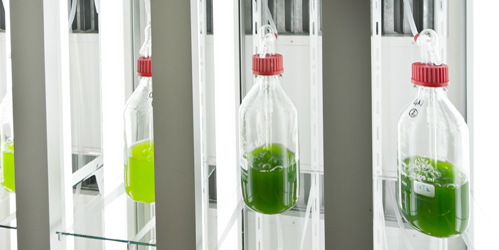Dr. Timothy Devarenne, AgriLife Research scientist with the Texas A&M University department of biochemistry and biophysics points out, “Oils from the green algae Botryococcus braunii can be readily detected in petroleum deposits and coal deposits suggesting that B. braunii has been a contributor to developing these deposits and may be the major contributor. This means that we are already using these oils to produce gasoline from petroleum.” He’s implying rather directly that green algae producing hydrocarbon oil as a biofuel production process is nothing new; nature has been doing so for hundreds of millions of years.
Devarenne explains B. braunii is a prime candidate for biofuel production because some races of the green algae typically “accumulate hydrocarbons from to 30 percent to 40 percent of their dry weight, and are capable of obtaining hydrocarbon contents up to 86 percent of their dry weight.” These are impressive numbers. “As a group, algae may be the only photosynthetic organism capable of producing enough biofuel to meet transportation fuel demands,” he says.
Devarenne is part of a team comprised of other scientists with AgriLife Research, the University of Kentucky and the University of Tokyo trying to understand more about B. braunii, including its genetic sequence and its family history. The point is, “Without understanding how the cellular machinery of a given algae works on the molecular level, it won’t be possible to improve characteristics such as oil production, faster growth rates or increased photosynthesis,” he says.
B. braunii, like most green algae, is capable of producing great amounts of hydrocarbon oils in a very small land area. B. braunii algae show particular promise not just because of their high production of oil but also because of the type of oil they produce.. While many high-oil-producing algae create vegetable-type oils, the oil from B. braunii, known as botryococcenes, are similar to petroleum.
Devarenne explains, “The fuels derived from B. braunii hydrocarbons are chemically identical to gasoline, diesel and kerosene. Thus, we do not call them biodiesel or bio-gasoline; they are simply diesel and gasoline. To produce these fuels from B. braunii, the hydrocarbons are processed exactly the same as petroleum is processed and thus generates the exact same fuels. Remember, these B. braunii hydrocarbons are a main constituent of petroleum. So there is no difference other than the millions of years petroleum spent underground.” He is almost making a new explanation of the formation of fossil fuels – which in this process wouldn’t be “fossil” at all. Interesting.
B. braunii has a problem – a relatively slow growth rate. While the algae that produce ‘vegetable-type’ oils may double their growth every six to 12 hours, B. braunii’s doubling rate is about four days. Devarenne says, “Thus, getting large amounts of oil from B. braunii is more time consuming and thus more costly. So, by knowing the genome sequence we can possibly identify genes involved in cell division and manipulate them to reduce the doubling rate.”
Here’s a surprise for you. Despite these characteristics and economic potential of algae, only six species of algae have had their genomes fully sequenced and annotated, Devarenne said. And B. braunii is not one of the six. I was surprised at such a low number too. Craig Venter with the Exxon effort must likely be on this as well as others, all with proprietary data.
Another point that may be delaying the genetic work is the nature of the algae. Devarenne explains, “Genomes with high guanine-cytosine content can be difficult to sequence and knowing the guanine-cytosine content can help to assess the amount of resources needed for genome sequencing,” Guanine-cytosine bonds are one of base pairs composing DNA structure. Adenine-thymine is the other possible base pair.
Devarenne and his colleagues are working the Berkeley strain of the B race of B. braunii, so named because it was first isolated at the University of California at Berkeley. The team has determined the genome size and an estimate of the B race’s guanine-cytosine content, both of which are essential to mapping the full genome, he said. There are also races A and L of B. braunii, but they were not looked at by the team.
The team has determined B. braunii’s genome size to be 166.2 ± 2.2 million base pairs, Devarenne said. In comparison the size of the human genome is about 3.1 billion base pairs. The genome of the house mouse is also about 3 billion base pairs. But the B. braunii genome size is larger than any of the other six previously sequenced green algae genomes.
The actual genome sequencing and mapping will be performed by Department of Energy’s Joint Genome Institute.
“We’ve submitted genomic DNA from B. braunii for the Joint Genome Institute to use in sequencing, but that hasn’t begun yet,” Devarenne said.
Its not new or a secret that B. braunii is an interesting algae. Rather the news is that now the sophistication and depth of research is getting much further into the field – and it’s a very big field. Pulling out genomes from algae known to form essentially petroleum oil is quite fascinating. The matter remains to be seen if modification skill can push productivity to comparable levels with vegetable oil producing species. Then the list of production issues must be solved.
If B. braunii or its close cousins can be modified to get to high production and the other production issues have solutions, the oil supply issue will begin its decent into history.



